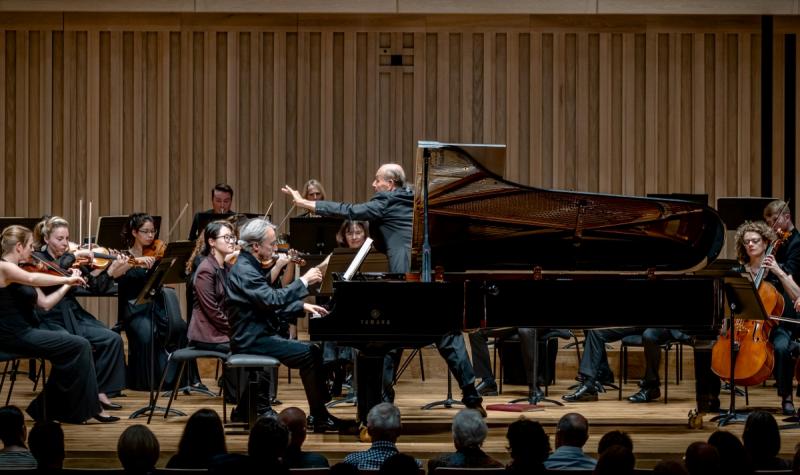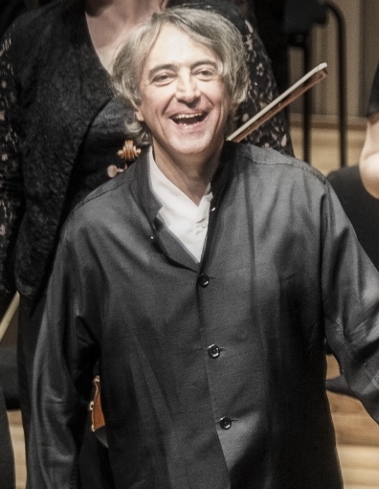Bavouzet, Manchester Camerata, Takács-Nagy, Stoller Hall, Manchester, review - concertos as opera | reviews, news & interviews
Bavouzet, Manchester Camerata, Takács-Nagy, Stoller Hall, Manchester, review - concertos as opera
Bavouzet, Manchester Camerata, Takács-Nagy, Stoller Hall, Manchester, review - concertos as opera
Drama takes the stage in characterful views of Mozart

Manchester Camerata’s series of in-concert recordings featuring Mozart piano concertos with Jean-Efflam Bavouzet is well under way now, and this programme, like others before it, included a couple of his opera o
Fair point – at least, it’s almost a truism that Mozart often introduces his themes as if they were full-fledged characters unveiling their personalities, that his structures can seem like glorified versions of classical arias, and that he loved to give his audiences a comedy-style finale. So that’s where Takács-Nagy is coming from here, and Bavouzet, playing a big-toned Yamaha concert grand, seems very content to go along with the idea of the concerto as drama, with himself in the limelight, hyped-up contrasts from the orchestral supporting cast, and helter-skelter final scenes.Takács-Nagy, at times, also seems to enjoy taking a vocal role in proceedings, an extension of the mini-opera concept which I could hear even on the very back row and which could conceivably give the recording engineers a little work to do, as there was no close-up mic-ing here.
The Camerata (cellos excepted, of course) stood up to deliver their opening overtures – first an actually operatic one, from Il Re Pastore (K208), played with vigorous and pointed articulation and soft-loud coups de théâtre a-plenty. Then Symphony No. 29 (K201), that miracle of teenage invention, which Takács-Nagy characterises as an example of the child-like in Mozart’s personality.
He’s right – but children can be seemingly innocent when there’s a lot going on behind the wide-eyed look. In his reading there was charm a-plenty in the first movement, delicacy in the second, jollity and even a touch of mock-adulthood in the minuet (and, which I liked, an unexpectedly solemn trio), and a waxing-and-waning delivery of the finale which was highly effective.
 Jean-Efflam Bavouzet (pictured left) played Piano Concerto N. 8 (K246) with C major fullness of tone and used the sustaining pedal to reinforce it. Its opening movement was almost a serenade-style march, its Andante a lovely solo aria with appropriate touches of whimsy, and its finale a parade of comedy turns in the episodes, ending with a chord that sounded like a door slamming shut on angry exit by the pianist, who’s disqualified from singing in the final chorus! Bavouzet’s cadenzas (echt-Mozart in this performance) brought in a touch of quizzicality in the first movement and some suitably vocalist-like showing off to finish the second.
Jean-Efflam Bavouzet (pictured left) played Piano Concerto N. 8 (K246) with C major fullness of tone and used the sustaining pedal to reinforce it. Its opening movement was almost a serenade-style march, its Andante a lovely solo aria with appropriate touches of whimsy, and its finale a parade of comedy turns in the episodes, ending with a chord that sounded like a door slamming shut on angry exit by the pianist, who’s disqualified from singing in the final chorus! Bavouzet’s cadenzas (echt-Mozart in this performance) brought in a touch of quizzicality in the first movement and some suitably vocalist-like showing off to finish the second.
The Overture to Zaide (K344) brought the full orchestra briefly onstage, with its four horns and double woodwind (ex clarinets), and again we were treated to flash-bang scenic effects, through both pace and dynamic contrast. It’s wonderfully listenable, and Gábor Takács-Nagy almost apologized for the over-emphases by telling us he’d realized they’re necessary to get the right result in the recordings.
Finally we heard Piano Concerto No. 9 (K271) – long known as the "Jeunehomme" but now more correctly nick-named "Jenamy’" after Victoire Jenamy, the lady for whom it was written. This is one of those works of genius of which one never tires. Jean-Efflam Bavouzet played the solo from memory, full of joie-de-vivre and with an engaging individuality animating the melodic flow (and a romp through the augmented sixths and flourishes of the cadenza). The C minor Andantino really was like an opera scena, with pathos and tragedy from the very opening and the cadenza more meditation than display.
And the Rondo – marked Presto – was avowedly as fast as they could make it, perhaps almost too fast for string articulation but giving Bavouzet every opportunity for soloistic fun and games – the sudden intervention of minuet tempo just one ironic quip among many – and sheer exuberance at the end.
rating
Explore topics
Share this article
The future of Arts Journalism
You can stop theartsdesk.com closing!
We urgently need financing to survive. Our fundraising drive has thus far raised £49,000 but we need to reach £100,000 or we will be forced to close. Please contribute here: https://gofund.me/c3f6033d
And if you can forward this information to anyone who might assist, we’d be grateful.

Subscribe to theartsdesk.com
Thank you for continuing to read our work on theartsdesk.com. For unlimited access to every article in its entirety, including our archive of more than 15,000 pieces, we're asking for £5 per month or £40 per year. We feel it's a very good deal, and hope you do too.
To take a subscription now simply click here.
And if you're looking for that extra gift for a friend or family member, why not treat them to a theartsdesk.com gift subscription?
more Classical music
 Echo Vocal Ensemble, Latto, Union Chapel review - eclectic choral programme garlanded with dance
Beautiful singing at the heart of an imaginative and stylistically varied concert
Echo Vocal Ensemble, Latto, Union Chapel review - eclectic choral programme garlanded with dance
Beautiful singing at the heart of an imaginative and stylistically varied concert
 Scott, Irish Baroque Orchestra, Whelan, RIAM, Dublin review - towards a Mozart masterpiece
Characteristic joy and enlightenment from this team, but a valveless horn brings problems
Scott, Irish Baroque Orchestra, Whelan, RIAM, Dublin review - towards a Mozart masterpiece
Characteristic joy and enlightenment from this team, but a valveless horn brings problems
 Classical CDs: Voice flutes, flugelhorns and froth
Baroque sonatas, English orchestral music and an emotionally-charged vocal recital
Classical CDs: Voice flutes, flugelhorns and froth
Baroque sonatas, English orchestral music and an emotionally-charged vocal recital
 Kanneh-Mason, Britten Sinfonia, Shave, Milton Court - a grin and a big beaming smile
A pair of striking contemporary pieces alongside two old favourites
Kanneh-Mason, Britten Sinfonia, Shave, Milton Court - a grin and a big beaming smile
A pair of striking contemporary pieces alongside two old favourites
 theartsdesk at the New Ross Piano Festival - Finghin Collins’ musical rainbow
From revelatory Bach played with astounding maturity by a 22 year old to four-hand jazz
theartsdesk at the New Ross Piano Festival - Finghin Collins’ musical rainbow
From revelatory Bach played with astounding maturity by a 22 year old to four-hand jazz
 First Person: Manchester Camerata's Head of Artistic Planning Clara Marshall Cawley on questioning the status quo
Five days of free events with all sorts of audiences around Manchester starts tomorrow
First Person: Manchester Camerata's Head of Artistic Planning Clara Marshall Cawley on questioning the status quo
Five days of free events with all sorts of audiences around Manchester starts tomorrow
 Goldscheider, Brother Tree Sound, Kings Place review - music of hope from a young composer
Unusual combination of horn, strings and electronics makes for some intriguing listening
Goldscheider, Brother Tree Sound, Kings Place review - music of hope from a young composer
Unusual combination of horn, strings and electronics makes for some intriguing listening
 theartsdesk Q&A: composer Donghoon Shin on his new concerto for pianist Seong-Jin Cho
Classical music makes its debut at London's K-Music Festival
theartsdesk Q&A: composer Donghoon Shin on his new concerto for pianist Seong-Jin Cho
Classical music makes its debut at London's K-Music Festival
 Helleur-Simcock, Hallé, Wong, Bridgewater Hall, Manchester review - moving lyricism in Elgar’s concerto
Season opener brings lyrical beauty, crisp confidence and a proper Romantic wallow
Helleur-Simcock, Hallé, Wong, Bridgewater Hall, Manchester review - moving lyricism in Elgar’s concerto
Season opener brings lyrical beauty, crisp confidence and a proper Romantic wallow
 Kohout, Spence, Braun, Manchester Camerata, Huth, RNCM, Manchester review - joy, insight, imagination and unanimity
Celebration of the past with stars of the future at the Royal Northern College
Kohout, Spence, Braun, Manchester Camerata, Huth, RNCM, Manchester review - joy, insight, imagination and unanimity
Celebration of the past with stars of the future at the Royal Northern College

Add comment